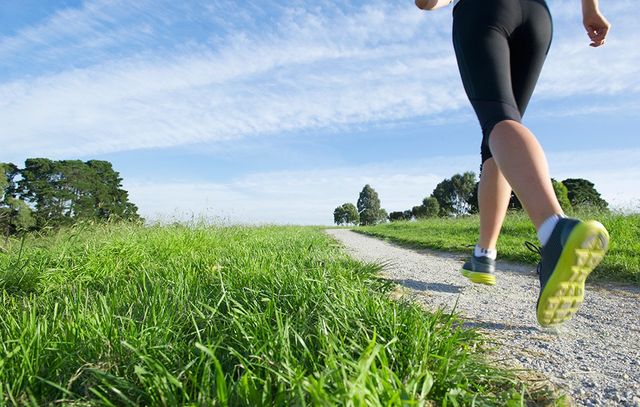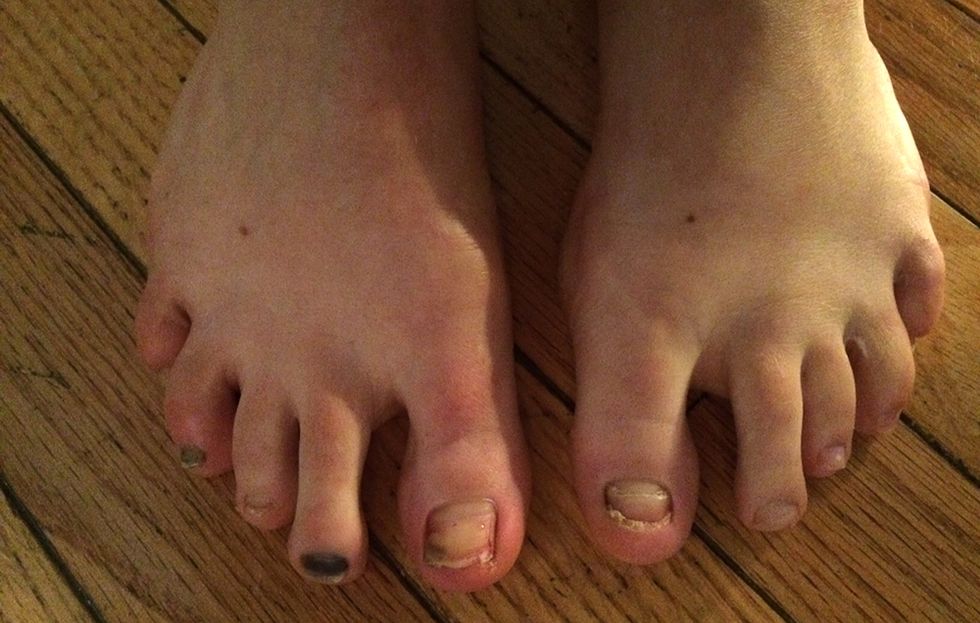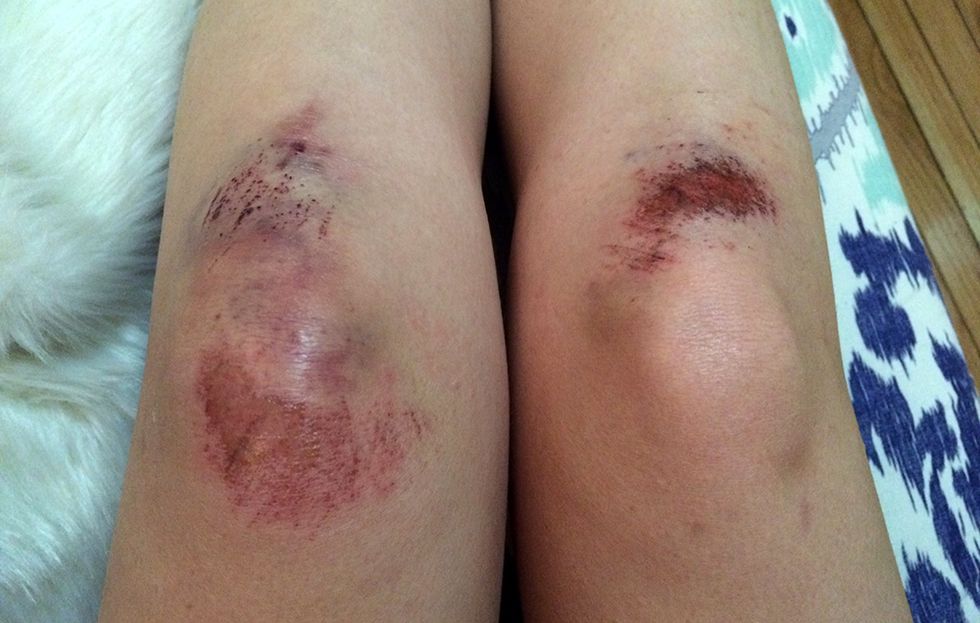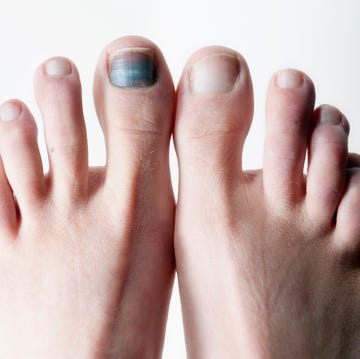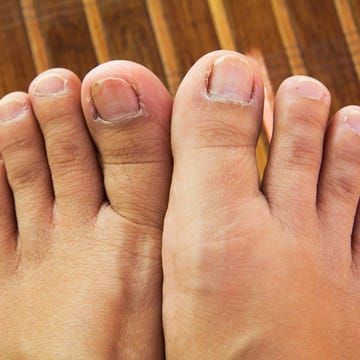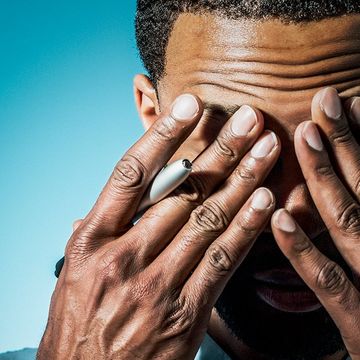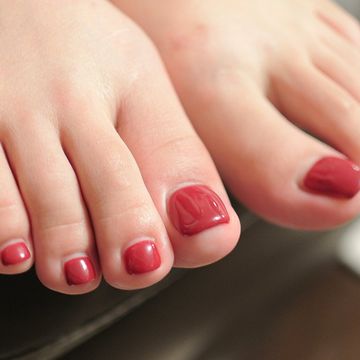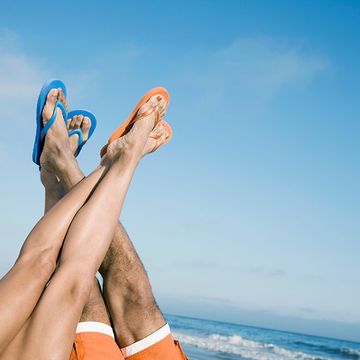Let’s cut to the chase: training for a marathon can be a pretty gnarly endeavor: nasty, unattractive and downright disgusting.
You see, when you begin running long distances, a lot of things happen to your body: surprising, strange, borderline repulsive things.
I’m about to compete in my first-ever 26.2 mile race: The New York City Marathon, on November 6. And while I can’t wait, when people ask how the training’s been, I have two words for them: not pretty.
Here are the weirdest, grossest things that have happened to me over the past four months—and how I overcame them to make it to the starting line anyway.
RELATED: Training for your own marathon? Try Runner’s World’s Marathon Training Plans to get you started.
1. My Big Toenail Bit the Dust
Two weeks into my training, I lost the big toenail on my left foot. It happened quickly, and painfully. The first sign of trouble was a throbbing sensation that developed after a 12-mile run. It hurt, but I was fired up, and not about to let a dumb ache stand my in way. I kept running, thinking the pain would pass if just powered through it.
But the ache only intensified during my next workout, a 6-mile tempo run. I got home and peeled back my sock to find a puffy, pulsating, bright red mass underneath my nail. Somehow the sudden mileage increase—combined with the fact that I hadn’t properly filed my nails—had created a massive blood blister that was elevating the nail off of my toe.
Related: All About Black Toenails
The throbbing was relentless. I was nervous that some type of infection was festering, so I went straight to the podiatrist. He remedied the situation in two fell swoops.
Step one: draining the blister. Step two: removing the entire nail. Both were surprisingly painless. What wasn’t painless was making it through the rest of sandal season sans big toenail. Let’s just say it wasn’t cute.
Why it didn’t stop me: This wasn’t my first lost toenail. As a lifelong skier, I’m no stranger to the event. So while my nail-less toe was unsightly, I wasn’t as fazed as I might have been. Also, luckily, the newly exposed skin didn’t hurt much at all. The day after the nail removal, I was able to resume my training.
What I did to solve the problem: I invested in a pair of nail clippers and started trimming. Ensuring no talons extended beyond my actual toes prevented them from banging up against my shoe—and banging themselves to death. But while I’m happy to report that all nine remaining nails are intact, two smaller nails have recently turned completely black, a sign of severe bruising that typically leads to nail loss. Sigh. Seems this problem is, to some extent, unavoidable.
2. My Bowels Turned Against Me
Before I started seriously training, I’d (thankfully) never heard of, or experienced, “runner’s trots.” Essentially, it’s running-induced diarrhea, and, it’s a common problem for long distance runners.
The worst moment came towards the end of a five-mile run, which was strange since the phenomenon typically occurs during longer distances. But then again, part of the evil of runner’s trots is that it arrives when you are LEAST expecting it. I was less than a quarter mile from home—just a few measly city blocks!—when the familiar cramps came on hard, fast, and seemingly out of nowhere. With lightning speed, they traveled down from my abdomen and twisted my bowels into knots.
Related: 8 Tips for Runners and GI Distress
I stopped mid-stride, fearing that if I kept going, I would become forever known in the neighborhood as the girl who pooped her pants on the sidewalk. I could see my apartment building a few blocks away, but it had never felt so far. I took a deep breath, clenched my cheeks together and gingerly walked forward.
Every step was torture. The knots grew tighter, and I nearly exploded in expletives when a red light stalled my journey for an agonizing 90 seconds. By some not-so-small miracle, I made it inside and dashed up the stairs to my second-story abode and onto the toilet before any real leakage occurred.
Why it didn’t stop me: I’m not going to lie. This incident rattled me, and I was nervous to hit the streets again for a few days. But I assuaged my GI worries by purposefully picking routes with ample bathrooms nearby.
What I did to solve the problem: I kept close tabs on my eating habits to learn what foods may be triggering the trots for me. Turns out some especially fiber-rich foods I’d been eating—like my nightly popcorn snack and this chickpea-based pasta I love—were possible culprits. I avoided eating those on nights before runs. This extra vigilance seemed to do the trick. There hasn’t been another trot situation since (knock on serious wood, please).
3. I Became Extremely Klutzy
I knew, of course, that the training would make me feel fatigued. But I didn’t foresee that the weariness could be dangerous.
You see, when I’m tired, I tend to drag my feet. And when I’m really tired—say, in the middle of a very long run—this apparently means I’m about to trip over my own two feet and face-plant horrendously.
Related: How to Prevent Common Running Injuries
Said face-planting happened twice during my training: the first time just a few blocks from my apartment, and the second time in Central Park towards the very end of a long run. Both instances were brutal, but I must have bled more the second time, because a slew of Good Samaritan pedestrians kept offering help as I nursed my wounds on a park bench.
A retired teacher insisted I use her scarf as a tourniquet. A young mom with a baby stroller provided wet wipes, which helped mop up the gore. And two German tourists saved the day with a bundle of Band-Aids. Unfortunately, no one had anything for my bruised ego.
Why it didn’t stop me: The battle wounds looked nasty, but healed quickly. So with careful cleaning and plenty of antibiotic ointment, I was able to get back out there within two days.
What I did to solve the problem: I did my best to get solid sleep on the two nights leading up to my weekly long runs. This wasn’t always feasible, so when running on empty, instead of zoning out and trying to mentally distract myself from the fatigue as I’d done previously, I focused on my feet and repeated the phrase “high knees, high knees!” as a reminder to pick up my darn tootsies.
4. My Sweat Marks Got Inappropriate
As my training really began ramping up, so did the summer heat wave. This resulted in a level of sweatiness unlike anything I’d experienced before. One particularly steamy August morning, I donned my breeziest attire—a light blue tank top and blue shorts—and tackled a 16-mile run. By the time I finished, pools of perspiration welled from every possible crevice of my body: my elbows, my knees, my clavicles, even my ankles.
Related: Why Runners Sweat More
Feeling like I’d just emerged from a two-hour sauna session, but also high on endorphins and proud of myself, I decided to pop into Starbucks for a celebratory iced coffee. Then I passed a corner grocery store and figured I should probably fetch a Gatorade and some bottled water as well. Finally, I stopped in at the dry cleaners’ to pick up a dress, and it was there, in the full-length mirror, that I realized the scandalous extent of my sweatiness. The perspiration on my chest had stained the light blue fabric in such a pattern that you could see a clear (read: very clear) outline of my bosoms. And that promptly concluded my post-long run errands.
Why it didn’t stop me: I realized the intense heat wave—and thus my grotesque perspiration—would only last so long, so I pushed on through the steaminess and quelled any embarrassment by remembering this (super cheesy) mantra: good things come to those who sweat.
What I did to solve the problem: For starters, I took that light blue tank top out of rotation and I began wearing darker colors for the remainder of my long summer runs. Even though the darker hues attracted more sunlight, it was worth it to avoid another unintentionally indecent exposure. Also, on the hottest and most humid days, I’d drag myself out of bed as early as possible to sneak in a run before the sun climbed too high.
5. I Chafed Like It Was Nobody’s Business
The intense chafing—between my thighs and along the edges of my bra straps—began when I started running longer than 15 miles. I’d feel the burn coming on during the run, and by the time I stepped in the shower, I’d have bright red, raw, splotchy patches marking the places where my clothes had hung. I wince just thinking about it now.
Related: How to Prevent & Treat Chafing
Why it didn’t stop me: Fortunately, chafing only reared its ugly head during my once-a-week long runs. That meant I had six full days to nurse the wounds and prep my skin for the next round of attack.
What I did to solve the problem: While there are plenty of running specific products that address this issue, I went with the simplest, cheapest option: Petroleum jelly. I dipped a Q-tip in the slimy substance and slathered it all over the problem areas before heading out. The goo acted as a lubricant and reduced the skin-to-skin friction while I ran.
6. My Nose Became an Endless Fountain of Phlegm
Picture Niagara Falls. Now replace the water with sticky, slimy snot. That was my nose on the majority of my longer runs. Once I hit a certain mile (usually between 7 to 10), the floodgates would open—and remain open for the remainder of the run. Thanks to gravity, the snot would often pool around my mouth. This made breathing difficult.
Why it didn’t stop me: I noticed many fellow runners suffering the same fate, so I figured it was a fairly common issue. I also noticed many of them using their t-shirts as giant tissues, so I unabashedly began doing the same.
What I did to solve the problem: Unfortunately, there’s not a lot I could do about this one. I tried blowing my nose as much as possible before runs in an attempt to “get it all out,” but this never really seemed to help. No matter how hard I honked my schnoz pre-run, the snot would magically just keep on flowing.
Watch: How to Blow Your Nose During a Run
7. My Bloating Reached Epic Proportions
The “Great Bloat” arrived—suddenly, and forcefully—around week three of my training. About 45 minutes after my long run, after I’d chugged a couple bottles of water and eaten a snack (like almonds or a granola bar), my belly would swell. The swelling would sometimes become so severe that I’d have to put on my stretchiest sweatpants and lie down on the bed until it passed. This sometimes took a couple hours. Twice I had to cancel plans with friends because the bloat refused to abate.
Related: Why Do I Retain Fluid after Long Runs?
Why it didn’t stop me: While the bloating was undeniably awful, it would only occur right after I exercised, so it fortunately never caused any pain or discomfort during my actual runs.
What I did to solve the problem: Good old H2O and proper nutrition. I Upped my water intake before, during and immediately after my runs, which seemed to help. I also started eating a small meal (like almond butter toast with a banana) about two hours before my run. The biggest solution, however, came when I started introducing a mid-run snack. Noshing on sports beans or a chia seed bar during my longer runs kept my stomach from kicking into starvation mode, which seemed to keep The Great Bloat at bay.

Jenny is a Boulder, Colorado-based health and fitness journalist. She’s been freelancing for Runner’s World since 2015 and especially loves to write human interest profiles, in-depth service pieces and stories that explore the intersection of exercise and mental health. Her work has also been published by SELF, Men’s Journal, and Condé Nast Traveler, among other outlets. When she’s not running or writing, Jenny enjoys coaching youth swimming, rereading Harry Potter, and buying too many houseplants.
